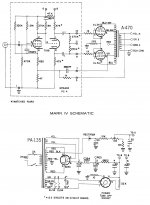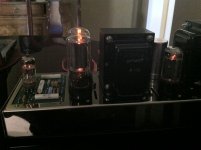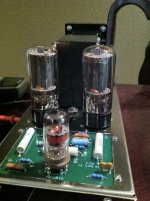I have a question about the 6800ohm resistor in the power supply, the schematic doesn't specify the wattage for this resistor,so I installed one with a 5 watt rating,The voltages look good when I first turn it on,but then smoke starts to come from the resistor, do I need a larger resistor?
Five watts should be plenty. Estimating 10mA through 6800 ohms gives a 68 volt drop and 0.68 watts. Perhaps a leaky 20ufd filter section or maybe the power take off socket is pulling current. Even if these numbers were doubled (1.5W) 5 watts should be enough. Try removing the 7199 as see what happens.
Attachments
HollowState is correct. Even a 2 watt resistor here is plenty. The fact that this resistor burned out on you (IMHO) is because of excessive current draw from some component on your Mark IV's driver board. If you have the original Mark IV driver board, you should probably replace the board and all parts on the board.
Bob Latino
Bob Latino
hey-Hey!!!,
the question I have is what happens to the voltage across that resistor as it overheats? IIRC that same value was used in the Mk.iii as well and it was a 1W carbon comp. At full saturation the rest of the front end can't draw that much current; 96k total for the PI and a 270k for the input pentode...or something a bit less than 10 mA...so the current must be going somewhere else.
cheers,
Douglas
the question I have is what happens to the voltage across that resistor as it overheats? IIRC that same value was used in the Mk.iii as well and it was a 1W carbon comp. At full saturation the rest of the front end can't draw that much current; 96k total for the PI and a 270k for the input pentode...or something a bit less than 10 mA...so the current must be going somewhere else.
cheers,
Douglas
Spoken like a true PCB vendor. Actually, the electrolytic cap (in the tall can) and can with plus on the end under the deck, are ten year life parts. One section (20 uf) is connected directly to your burning 6800 resistor. I've replaced the electrolytic caps on my 1961 ST70 three times since I bought it in 1970. The McIntosh salesman (1970) who tested the amp pointed out the outdated cap was keeping my wattage out down to 7w/channel. I put a new can cap in 1984, then didn't use it much because the 6CA7s were tired and replacements were sole sourced from the USSR at the time. I bought some Slovak tubes this year, tried to run them with the old practically unused cap, and it ran one night, before leaking the fluid out and blowing the fuse. Oxygen never sleeps, the rubber seals had gone bad. I get my can caps from tubesandmore.com or triodeelectronics.com, but for this time put radial lead 3000 hour electrolytic caps under the deck with solder terminal strips and 600 v wire. I plugged the can hole with a galvanized metal mesh.If you have the original Mark IV driver board, you should probably replace the board and all parts on the board.
Bob Latino
The advantage to new high value (100k and up) metal film resistors instead of carbon comp, is less hiss. The advantage of metal film dropping resistors (3 W or up) is they are more stable than carbon comp.I get my metal film resistors from newark.com, $.07 to $.33 for the house brand or Vishay from India. I replaced the paper .1 uf caps with plastic film caps, but didn't hear any difference. I'm not fooling with the mica cap.
There are driver boards that use commonly available dual triode tubes instead of the unobtainable 7199, that people say have less distortion. . There is a more complete discussion under the ST70 topic, same circuit diagram almost, but an amp that sold a lot more units.
Have fun. My St70 sounds great with 1970 7199's and new JJ 6CA7's. Not quite up to the Peavey CS800s, but that is a $1000 amp, not a $100 amp like the ST70 was.
Last edited:
Bob spoke like a true PCB vendor. Getting your amp to stop setting parts on fire should be primary, improving the sound with the pcb should be secondary. Actually, the electrolytic cap (in the tall can) and can with plus on the end under the deck, are ten year life parts. One section (20 uf) is connected directly to your burning 6800 resistor. I've replaced the electrolytic caps on my 1961 ST70 three times since I bought it in 1970. The McIntosh salesman (1970) who tested the amp pointed out the outdated cap was keeping my wattage out down to 7w/channel. I put a new can cap in 1984, then didn't use it much because the 6CA7s were tired and replacements were sole sourced from the USSR at the time. I bought some Slovak tubes this year, tried to run them with the old practically unused cap, and it ran one night, before leaking the fluid out and blowing the fuse. Oxygen never sleeps, the rubber seals had gone bad. I get my can caps from tubesandmore.com or triodeelectronics.com, but for this time put radial lead 3000 hour electrolytic caps under the deck with solder terminal strips and 600 v wire. I plugged the can hole with a galvanized metal mesh.
The advantage to new high value (100k and up) metal film resistors instead of carbon comp, is less hiss. The advantage of metal film dropping resistors (3 W or up) is they are more stable than carbon comp.I get my metal film resistors from newark.com, $.07 to $.33 for the house brand or Vishay from India. I replaced the paper .1 uf caps with plastic film caps, but didn't hear any difference. I'm not fooling with the mica cap.
There are driver boards that use commonly available dual triode tubes instead of the unobtainable 7199, that people say have less distortion. . There is a more complete discussion under the ST70 topic, same circuit diagram almost, but an amp that sold a lot more units.
Have fun. My St70 sounds great with 1970 7199's and new JJ 6CA7's. Not quite up to the Peavey CS800s, but that is a $1000 amp, not a $100 amp like the ST70 was.[/QUOTE]
The advantage to new high value (100k and up) metal film resistors instead of carbon comp, is less hiss. The advantage of metal film dropping resistors (3 W or up) is they are more stable than carbon comp.I get my metal film resistors from newark.com, $.07 to $.33 for the house brand or Vishay from India. I replaced the paper .1 uf caps with plastic film caps, but didn't hear any difference. I'm not fooling with the mica cap.
There are driver boards that use commonly available dual triode tubes instead of the unobtainable 7199, that people say have less distortion. . There is a more complete discussion under the ST70 topic, same circuit diagram almost, but an amp that sold a lot more units.
Have fun. My St70 sounds great with 1970 7199's and new JJ 6CA7's. Not quite up to the Peavey CS800s, but that is a $1000 amp, not a $100 amp like the ST70 was.[/QUOTE]
I apologize folks,I was leading you astray. It was a screw-up on my part. By the way in case your wondering this is a NEW build. Theres nothing wrong with the cap,I mistakenly mis-wired the take-off socket. the wire was supposed to be soldered to pin #4 and the 22K resistor,was soldered to pin #3 by mistake,which would take the current through the 10ohm resistor straight to ground.
It would have been helpful and courteous to tell us from the beginning that it was a new DIY build. Fault-finding depends partly on context, which you did not disclose. Debugging a build and fixing a previously working item are not the same thing, because different types of fault are likely to occur.
It would have been helpful and courteous to tell us from the beginning that it was a new DIY build. Fault-finding depends partly on context, which you did not disclose. Debugging a build and fixing a previously working item are not the same thing, because different types of fault are likely to occur.
My humble apologies! I need to develop better board ethics!!
DF96,
I tried telling that to someone on the PASS forum, he had built an A40 and had a bad channel, forgot the particular problem. He had one good channel to troubleshoot with but kept asking what would cause this problem. I told him troubleshooting a once working amp is totally different than something he built and NEVER worked. I don't think he cared for that, never saw him again on the forum.
Craig
I tried telling that to someone on the PASS forum, he had built an A40 and had a bad channel, forgot the particular problem. He had one good channel to troubleshoot with but kept asking what would cause this problem. I told him troubleshooting a once working amp is totally different than something he built and NEVER worked. I don't think he cared for that, never saw him again on the forum.
Craig
I apologize folks,I was leading you astray. It was a screw-up on my part. By the way in case your wondering this is a NEW build. Theres nothing wrong with the cap,I mistakenly mis-wired the take-off socket. the wire was supposed to be soldered to pin #4 and the 22K resistor,was soldered to pin #3 by mistake,which would take the current through the 10ohm resistor straight to ground.
Oops, yep that will do it.. Good catch..
Oops, yep that will do it.. Good catch..
You have that right!!! If I only double checked my work I would have discovered it,and this post wouldn't have been nessessary. All is good now. This jewel of an amp seems to be working the way it was designed to do,my hats off to Mr. Hafler,and Mr. Laurent for designing some great products!
- Status
- This old topic is closed. If you want to reopen this topic, contact a moderator using the "Report Post" button.
- Home
- Amplifiers
- Tubes / Valves
- Dynaco Mark IV Power Resistor


